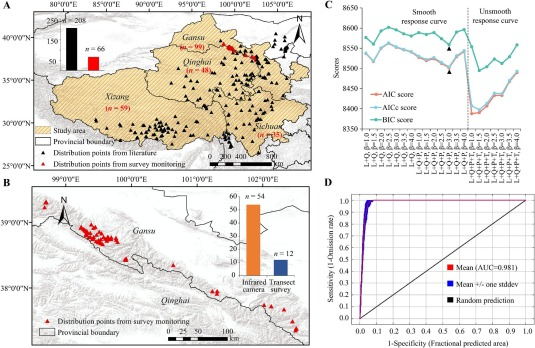With the rapid socio-economic development, intensified land use and population growth have severely threatened global biodiversity, particularly on the Qinghai-Tibet Plateau, a global biodiversity hotspot where many endangered species face significant habitat loss and fragmentation. The alpine musk deer (Moschus chrysogaster), a species endemic to the Qinghai-Tibet Plateau and one of the most endangered species globally, requires critical habitat assessment and conservation efforts for regional and global biodiversity protection. This study integrated data from 274 alpine musk deer occurrence points, obtained through infrared camera monitoring, field surveys, and literature reviews, with environmental variables, employing the MaxEnt model to analyze the current spatial distribution of suitable habitats and priority conservation areas in Western China. We calculated conservation effectiveness and identified gaps within four western provinces using ArcGIS. Results indicated that altitude, annual mean temperature, and temperature annual range were the primary environmental factors influencing the distribution of suitable habitats, which were concentrated in areas with altitudes of 3,000–5,000 m, annual mean temperatures of 0–5 °C, and temperature annual ranges of 30–40 °C. The suitable habitats were mainly distributed in central and southern Gansu, northeastern and scattered southern regions of Qinghai, central and western Sichuan, and central and eastern Xizang, with Xizang having the largest area of highly suitable habitat, Qinghai having the largest area of moderately suitable habitat, and Sichuan having the highest proportion of highly suitable habitat, while overall, Qinghai had the highest proportion of priority conservation areas. The suitability of habitats within national nature reserves in Western China varied significantly, with Sichuan’s reserves showing the highest efficiency in protecting highly suitable habitats, and all four provinces exhibited significant conservation gaps. The study recommends maintaining suitable habitats, optimizing nature reserve layouts, establishing conservation gaps, and restoring ecosystems to protect alpine musk deer habitats and promote biodiversity health.

Fig. 1. Distribution points and model validation for alpine musk deer in western China. (A) Map showing distribution points of alpine musk deer across different provinces in western China; (B) Map indicating field survey distribution points of alpine musk deer in the Qilian Mountain region; (C) Statistical analysis of AIC, AICc, and BIC values for different parameter combinations; (D) Accuracy analysis curve for the MaxEnt model's habitat suitability simulation for alpine musk deer.
The link below will guide you to the reading:
